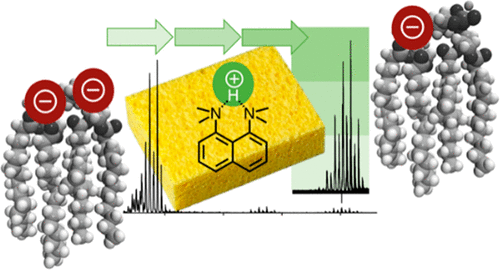当前位置:
X-MOL 学术
›
Anal. Chem.
›
论文详情
Our official English website, www.x-mol.net, welcomes your
feedback! (Note: you will need to create a separate account there.)
Proton Transfer Reactions for the Gas-Phase Separation, Concentration, and Identification of Cardiolipins.
Analytical Chemistry ( IF 6.7 ) Pub Date : 2020-07-08 , DOI: 10.1021/acs.analchem.0c02545 Caitlin E Randolph 1 , Kimberly C Fabijanczuk 1 , Stephen J Blanksby 2 , Scott A McLuckey 1
Analytical Chemistry ( IF 6.7 ) Pub Date : 2020-07-08 , DOI: 10.1021/acs.analchem.0c02545 Caitlin E Randolph 1 , Kimberly C Fabijanczuk 1 , Stephen J Blanksby 2 , Scott A McLuckey 1
Affiliation

|
Cardiolipin (CL) analysis demands high specificity, due to the extensive diversity of CL structures, and high sensitivity, due to their low relative abundance within the lipidome. While electrospray ionization mass spectrometry (ESI-MS) is the most widely used technology in lipidomics, the potential for multiple charging presents unique challenges for CL identification and quantification. Depending on the conditions, ESI-MS of lipid extracts in negative ion mode can give rise to cardiolipins ionized as both singly and doubly deprotonated anions. This signal degeneracy diminishes the signal-to-noise ratio, while in addition (for direct infusion), the dianion population falls within a m/z range already heavily congested with monoanions from more abundant glycerophospholipid subclasses. Herein, we describe a direct infusion strategy for CL profiling from total lipid extracts utilizing gas-phase proton-transfer ion/ion reactions. In this approach, lipid extracts are ionized by negative ion ESI generating both singly deprotonated phospholipids and doubly deprotonated CL anions. Charge reduction of the negative ion population by ion/ion reactions leads to an enhancement in singly deprotonated [CL – H]− species via proton transfer to the corresponding [CL – 2H]2–̅ dianions. To concentrate the [CL – H]− anion signal, multiple iterations of ion accumulation and proton-transfer ion/ion reaction can be performed prior to subsequent interrogation. Mass selection and collisional activation of the enriched population of [CL – H]− anions facilitates the assignment of individual fatty acyl substituents and phosphatidic acid moieties. Demonstrated advantages of this new approach derive from the improved performance in complex mixture analysis affording detailed characterization of low abundant CLs directly from a total biological extract.
中文翻译:

用于心磷脂气相分离、浓缩和鉴定的质子转移反应。
心磷脂 (CL) 分析需要高特异性(由于 CL 结构的广泛多样性)和高灵敏度(因为它们在脂质组内的相对丰度较低)。虽然电喷雾电离质谱 (ESI-MS) 是脂质组学中使用最广泛的技术,但多次充电的潜力给 CL 识别和定量带来了独特的挑战。根据条件,负离子模式下的脂质提取物的 ESI-MS 可以产生电离为单去质子化阴离子和双去质子化阴离子的心磷脂。这种信号简并性降低了信噪比,同时另外(对于直接输注),二价阴离子群体落在已经严重挤满来自更丰富的甘油磷脂亚类的单价阴离子的m / z范围内。在此,我们描述了利用气相质子转移离子/离子反应从总脂质提取物中进行 CL 分析的直接输注策略。在这种方法中,脂质提取物被负离子 ESI 电离,产生单去质子化磷脂和双去质子化 CL 阴离子。通过离子/离子反应减少负离子群的电荷,通过质子转移到相应的 [CL - 2H] 2– ̅ 二价阴离子,导致单去质子化 [CL - H] -物质的增强。为了集中 [CL – H] -阴离子信号,可以在后续询问之前执行离子积累和质子转移离子/离子反应的多次迭代。[CL – H] -阴离子富集群的质量选择和碰撞激活有利于单个脂肪酰基取代基和磷脂酸部分的分配。这种新方法所展示的优势源自复杂混合物分析中性能的改进,可直接从总生物提取物中提供低丰度 CL 的详细表征。
更新日期:2020-08-04
中文翻译:

用于心磷脂气相分离、浓缩和鉴定的质子转移反应。
心磷脂 (CL) 分析需要高特异性(由于 CL 结构的广泛多样性)和高灵敏度(因为它们在脂质组内的相对丰度较低)。虽然电喷雾电离质谱 (ESI-MS) 是脂质组学中使用最广泛的技术,但多次充电的潜力给 CL 识别和定量带来了独特的挑战。根据条件,负离子模式下的脂质提取物的 ESI-MS 可以产生电离为单去质子化阴离子和双去质子化阴离子的心磷脂。这种信号简并性降低了信噪比,同时另外(对于直接输注),二价阴离子群体落在已经严重挤满来自更丰富的甘油磷脂亚类的单价阴离子的m / z范围内。在此,我们描述了利用气相质子转移离子/离子反应从总脂质提取物中进行 CL 分析的直接输注策略。在这种方法中,脂质提取物被负离子 ESI 电离,产生单去质子化磷脂和双去质子化 CL 阴离子。通过离子/离子反应减少负离子群的电荷,通过质子转移到相应的 [CL - 2H] 2– ̅ 二价阴离子,导致单去质子化 [CL - H] -物质的增强。为了集中 [CL – H] -阴离子信号,可以在后续询问之前执行离子积累和质子转移离子/离子反应的多次迭代。[CL – H] -阴离子富集群的质量选择和碰撞激活有利于单个脂肪酰基取代基和磷脂酸部分的分配。这种新方法所展示的优势源自复杂混合物分析中性能的改进,可直接从总生物提取物中提供低丰度 CL 的详细表征。











































 京公网安备 11010802027423号
京公网安备 11010802027423号